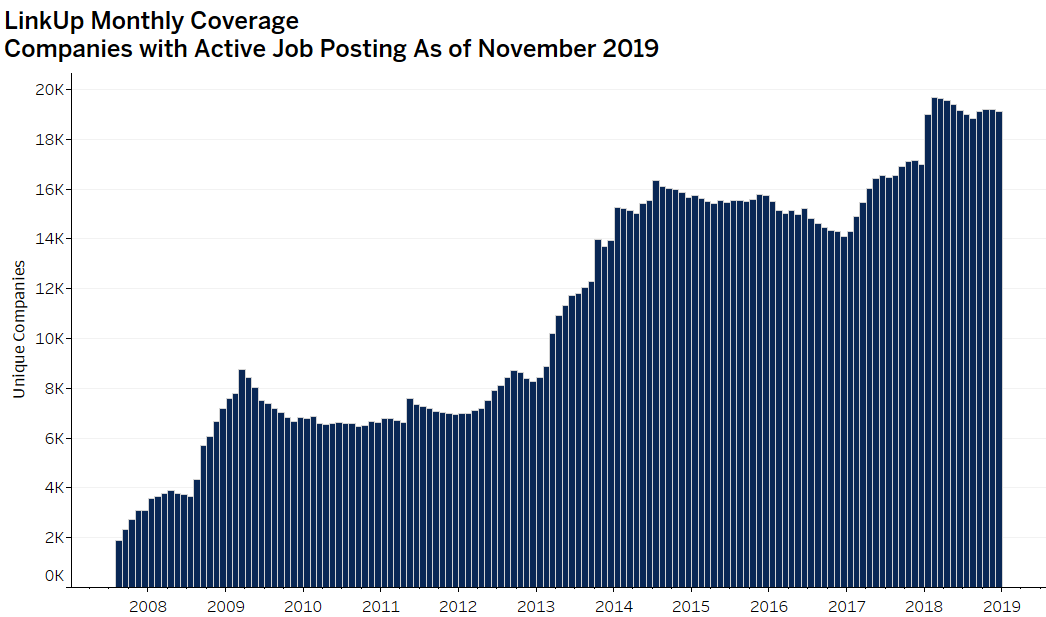Basics
Content Category: Human Capital
Open:FactSet Page: Click here
Setup a Demo and Access Today: sales@factset.com
LinkUp’s primary business is to provide the highest-quality index of global job listings for job seekers. The by-product of this business is a robust and clean job listing data set with a deep history that can be applied to gain valuable insights into the global labor market and insights at the macro, sector, geographic, and individual company level.
LinkUp Raw contains the most complete set of LinkUp’s job market data, dating back to 2007. The data set includes full job postings sourced directly from employer websites as well as related statistics and analysis of the job postings. Delivered daily, LinkUp Raw consists of 3 distinct components: individual job records, core analytics, and company reference data. The dataset includes over 20 unique job and company level attributes and identifiers, such as, job title, job URL, company name, location, occupation code, sector code, ticker, reference data, and more.
Data Overview
Asset Class: Public and Private Companies.
Data Frequency: Daily
Delivery Frequency: Daily
History: 2007

Data Methodology
LinkUp sources all job posting information from publicly available websites. They do not collect data from end users or consumers. Data is collected directly from employer websites by indexing jobs that are publicly available. LinkUp scrapes 100% of publicly traded U.S. companies that have jobs on their website. About 15% of public companies currently do not post jobs on their website. ~75% of companies in the database are private.
Daily, LinkUp indexes millions of job listings direct from employers by maintaining a unique process for each hiring URL within their coverage universe. Their web spiders assess each page to extract structured information for each individual job. This process runs continuously with every job being scraped and updated by LinkUp within 24-48 hours.
Their proprietary scrape technology and dedicated scrape team flags, prioritizes, and updates all breaks and changes to ensure a consistent and clean data set. All job posting information that is scraped is then cleaned, parsed, and normalized.
With data starting in 2007, LinkUp provides daily aggregate values summarizing unique active jobs, jobs created, jobs deleted, and the daily average "lifespan" of active jobs for a company’s career page. Individual Job Posting information is available starting in 2007.
Use Cases
Company
Job postings for a firm can inform investors of its overall health and the strategic direction of the firm.
- Companies under distress typically show signs of a decrease in job posting creation, job deletions outpacing creation, or an overall decrease in unique active jobs. On the other hand, hiring behavior can be highly correlated with company revenues. A company may increase job postings based on quarterly performance in advance of reporting to the street.
- The inclusion of the standardized O*NET job taxonomy enables investors to analyze trends based on position type, skill set, or title. For example, job postings can help identify industries and companies who are new areas or technologies, e.g. blockchain.
Sector
Evaluating the job posting behavior of a sector or industry can help identify trends, talent shortages, or a shift in skill set demands.
- Analyzing the job growth year-over-year within a given sector or sub-sector can be a leading indicator to performance.
- Tracking average, the duration for a job posting across a sector or for a specific role within an industry can be useful within peer analysis. For example, is there a talent shortage for aerospace engineers? Are Lockheed Martin and Boeing exhibiting similar time horizons on filling open positions?
Macro
LinkUp’s extensive coverage universe allows investors to understand job demand and hiring trends across geographies, industries, and occupations.
- The most direct use case would be to leverage this data set in totality to gauge the overall health of the economy, predict growth, volatility, and employment rates.
- The geographic granularity provided alongside job postings allows for detailed analysis of a city, state, or even zip code. This can be used to understand demographic shifts by analyzing the types of positions being posted: high cost versus low cost positions, daycares versus retirement homes postings, or construction jobs versus overall job postings.
The details provided above are as of November 2019.
If you have any questions or would like to learn more about any of the content mentioned above, please contact us at sales@factset.com.
Please visit the product page on the Open:FactSet Marketplace for more information: LinkUp Raw.



